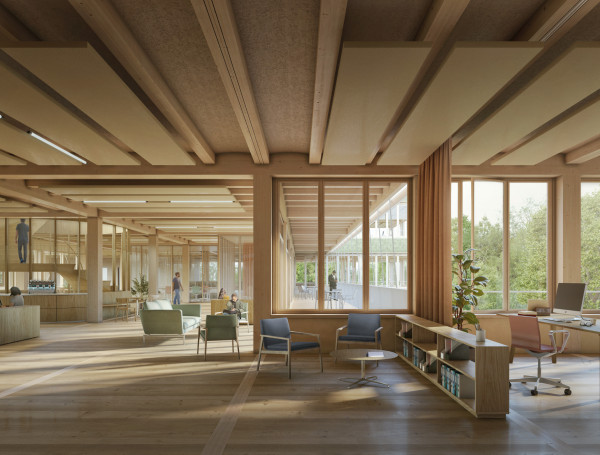The double cour d'honneur, an appropriate urban shape
The two-sided orientation towards Rheinstrasse and Falkenweg determines the specific urban planning shape of the new administration building. In historical reference to the Berrigut opposite, a double cour d'honneur allows the building to be addressed from both Rheinstrasse and Falkenweg. The resulting H-shape also reflects the functional disposition of the building. The two side wings house the BUD and the BKSD respectively, while the central building forms the social centre that serves both directorates and unites them.
Selective competition
Kreuzboden
New Administration Building
 Administration building
Liestal
Administration building
Liestal Switzerland






The Kreuzboden, an area with a two-sided orientation
From a conventional perspective, Rheinstrasse is the address of the Kreuzboden area. However, this clear orientation is called into question by contemporary mobility behaviour with a focus on public transport and non-motorised traffic. The seemingly rearward development along the railway embankment thus comes into focus and makes the Kreuzboden appear as a two-sided area.
The Falkenweg, an attractive slow traffic axis
The two-sided orientation of the area requires the upgrading of the existing path at the foot of the railway embankment into an attractive and continuous non-motorised traffic axis. In reference to the local history, we call this Falkenweg. Falkenweg connects Floraweg with Kreuzbodenweg and, at a higher level, Oristalstrasse with Spitalstrasse. As a footpath, the Falkenweg creates an efficient connection to Liestal railway station and as a cycle path, it complements the network between the cantonal cycle route on Rheinstrasse and the national cycle route 3 on the opposite side of the railway embankment.
The building shape leads to a versatile interweaving of the park and the public uses on the ground floor such as reception, conference centre and catering. This interweaving is reinforced by the passages in the two side wings. The passage in the south-west wing
serves as a passageway for the Falkenweg and also provides access to the central bicycle car park. The passage in the north-east wing marks the interface to the above-ground car park and serves to connect the existing administrative buildings.

The embedding of the building, minimal intervention in the terrain and maximum reduction of concrete
A timber construction with an appropriate and functional grid and direct load transfer throughout form an efficient load-bearing structure and characterise the new administration building.
Thanks to the skilful embedding in the existing topography and the omission of an underground car park, the footprint and underground volume are reduced to a maximum. The building does not even have to have a full basement in order to comply with the spatial programme and ensure the arrangement of the necessary technical centres. This configuration reduces the use of concrete to an absolute minimum. Apart from the basement, concrete is only used for the two bracing access cores.

The building envelope, a contemporary, timeless and durable cladding
The building envelope is characterised by a simple construction with a high degree of prefabrication which, like the timber supporting structure, allows quick and precise assembly on site. Prefabricated timber-composite elements form the parapet bands, which are mounted to the outer beams of the primary structure.
The sill strips clad with wind paper are additionally protected by the curtain-type PV panels coloured using Morpho technology. These are mounted on the ZIP guide rails of the fabric blinds. The guide rails are inclined outwards to give the round blind boxes a protected position and improve the utilisation of solar energy. This arrangement and the ideal proportions between the windows without solar control glazing and the closed parapets allow both efficient thermal insulation in summer and optimised solar gain in winter. This leads to a significant reduction in heating requirements.
Floor-to-ceiling glazing is used in the centre building to make the two entrance façades more open. Here, the PV-clad parapet strips are replaced by balustrades in the same formal arrangement. In the south, the balconies provide passive solar shading in summer and the fabric blinds, as on the north façade, are primarily used to moderate the atmosphere of the space, e.g. to increase the privacy of the interior.
The same formal arrangement of the outer skin is also used on the façade of the park tower. However, here the fabric blinds are replaced by additional PV panels.
Team
Architect:
Studio Gugger
Landschaftsarchitect:
Maurus Schifferli Landschaftsarchitekt
Civil engineer/Timber construction engineer:
ARGE Lauber Ingenieure AG / Gruner AG
Noise Protection:
Gartenmann Engineering AG
Building technology and plumbing systems:
Eicher + Pauli Liestal AG
Electrical engineer:
HKG Engineering AG Pratteln
Sustainability:
Nova Energie Basel AG
Building physics, acoustics:
Bakus Bauphysik & Akustik AG
Fire protection:
Quantum Brandschutz GmbH
Façade planner:
PPEngineering GmbH


















